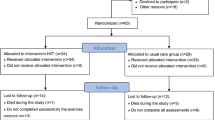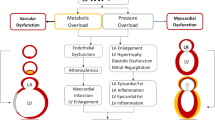Abstract
Purpose
Most training studies in patients with chronic heart failure (CHF) do not consider CHF aetiology in the interpretation of the results. About 60% of the patients in those studies have ischemic CHF (IHF) and 40% non-ischemic CHF (NHF). Recently, we conducted a randomized controlled trial to study three different training modalities in 60 patients with severe CHF, with a similar distribution of IHF and NHF patients. In the present post hoc analysis we compared the differences in training results between ischemic and non-ischemic patients.
Methods
Left ventricular ejection fraction (EF), end diastolic volume (EDV), end systolic volume (ESV), measured with radionuclide ventriculography (RNV) and echocardiography, NT-pro BNP, peak oxygen uptake (peak \(V_{{{\rm O}_{2} }} \)), working capacity and muscular volume were analyzed before and after training in 45 patients training for 40 sessions, 3 times per week. Fifteen patients served as control group. The outcome was analyzed considering the aetiology of CHF, either ischemic or non-ischemic.
Results
There were no significant differences in improvements of peak \(V_{{{\rm O}_{2} }}\), working capacity and muscular volume between IHF and NHF patients. In NHF patients, EF increased while EDV and ESV decreased after training. These parameters remained unchanged in IHF patients after training. NT-pro BNP decreased significantly in NHF patients and increased in IHF patients after training. In the control group, patients showed a mild improvement of EF and a decrease of NT-pro BNP.
Conclusion
This post hoc analysis shows that training intervention is associated with significant reverse remodelling in NHF, but not in IHF patients, whereas \( V_{{{\rm O}_{2} }} \) peak and muscle volume improve regardless of CHF aetiology. Future prospective studies are needed to confirm our findings.


Similar content being viewed by others
References
Anand IS, Fisher LD, Chiang YT et al (2003) Changes in brain natriuretic peptide and norepinephrine over time and mortality and morbidity in the Valsartan Heart Failure Trial (Val-Heft). Circulation 107:1278–1283
Bart BA, Shaw LK, McCants CB Jr (1997) Clinical determinants of mortality in patients with angiographically diagnosed ischemic or nonischemic cardiomyopathy. J Am Coll Cardiol 30:1002–1008
Bristow MR, Saxon LA, Boehmer J et al (2004) Cardiac-resynchronization therapy with or without an implantable defibrillator in advanced chronic heart failure. N Engl J Med 350:2140–2150
Cicoira M, Zanolla L, Franceschini L, Rossi A, Golia G, Zamboni M, Tosoni P, Zardini P (1999) Skeletal muscle mass independently predicts peak oxygen consumption in non cachectic patients with chronic heart failure. Circulation 99:1138–1140
Coats AJS (1999) Exercise training for heart failure coming of age. Circulation 99:1138–1140
Conraads VM, Beckers P, Vaes J et al (2004) Combined endurance/resistance training reduces NT-pro BNP levels in patients with chronic heart failure. Eur Heart J 25:1797–1805
Delagardelle C, Feiereisen P, Autier P et al (2002) Strength/endurance training versus endurance training in congestive heart failure. Med Sci Sports Exerc 34:1868–1872
European heart failure training group (1998) Experience from controlled trials of physical training in chronic heart failure. Eur Heart J 19:466–475
Feiereisen P, Delagardelle C, Vaillant M, Lasar Y, Beissel J (2007) Is strength training the more efficient training modality in chronic heart failure? Med Sci Sports Exerc 39:1910–1917
Felker GM, Thompson RE, Hare JM et al (2000) Underlying causes and long-term survival in patients with initially unexplained cardiomyopthy. N Engl J Med 342:1077–1084
Follath F, Cleland JGF, Klein W, Murphy R (1998) Aetiology and response to drug treatment in heart failure. J Am Coll Cardiol 32:1167–1172
Goetze JP (2005) Coronary artery disease, heart failure and cardiac natriuretic peptides in the middle. Eur Heart J 26:2603–2604
Hambrecht R, Gielen S, Linke A et al (2000) Effects of exercise training on left ventricular function and peripheral resistance in patients with chronic heart failure: a randomized trial. JAMA 283:3095–30101
Haykowsky MJ, Yuanyuan L, Pechter D et al (2007) A meta.analysis of the effect of exercise training on left ventricular remodeling in heart failure patients. J Am Coll Cardiol 49:2329–2333
Iwanaga Y, Nishi I, Furuichi S et al (2006) B-type natriuretic peptide strongly reflects diastolic wall stress in patients with chronic heart failure. J Am Coll Cardiol 47:742–748
Kragelund C, Gronning B, Kober L et al (2005) N-terminal pro-B-type natriuretic peptide and long-term mortality in stable coronary heart disease. N Engl J Med 352:666–675
Maron BJ (ed) (2006) AHA scientific statement contemporary definitions and classification of the cardiomyopathies. Circulation 113:1807–1816
Mc Kelvie RS, Teo KK, Roberts R et al (2002) Effects of exercise training in patients with heart failure: the exercise rehabilitation trial (EXERT). Am Heart J 144: 23–30
Navarro Estrada JL, Rubinstein F et al (2006) NT-probrain natriuretic peptide predicts complexity and severity of the coronary lesions in patients with non-ST elevation acute coronary syndromes. Am Heart J 151:1093–1105
Passino C, Severino S, Poletti R et al (2006) Aerobic training decreases B-type natriuretic peptide expression and adrenergic activation in patients with heart failure. J Am Coll Cardiol 47:1835–1839
Piepoli MF, Davos C, Francis DP, Coats AJS (2004) Exercise training meta-analysis of trials in patients with chronic heart failure (ExTtraMATCH). BMJ 328:189–192
Shephard RJ (1996) Exercise for patients with congestive heart failure. Sports Med 23:75–92
Webb-Peploe K, Chua TP, Harrington D, Henein MY, Gibson DG, Coats AJS (2000) Different response of patients with idiopathic and ischaemic dilated cardiomyopathy to exercise training. Int J Cardiol 74:215–224
Zannad F, Briançon S, Jullière Y et al (1999) Incidence, clinical and etiological features and outcomes of advanced chronic heart failure: the EPICAL STUDY. J Am Coll Cardiol 33:734–742
Acknowledgments
This work was supported by the “Société Luxembourgeoise pour la recherche sur les maladies cardiovasculaires”.
Author information
Authors and Affiliations
Corresponding author
Rights and permissions
About this article
Cite this article
Delagardelle, C., Feiereisen, P., Vaillant, M. et al. Reverse remodelling through exercise training is more pronounced in non-ischemic heart failure. Clin Res Cardiol 97, 865–871 (2008). https://doi.org/10.1007/s00392-008-0698-x
Received:
Accepted:
Published:
Issue Date:
DOI: https://doi.org/10.1007/s00392-008-0698-x




